
-
By:
- dane
- No comment
candle wick guide
Welcome to the candle wick guide‚ your comprehensive resource for understanding the crucial role of wicks in candle-making. Explore wick types‚ materials‚ and selection tips to ensure optimal burn performance and fragrance throw in your creations.
Importance of Choosing the Right Candle Wick
Selecting the right candle wick is crucial for ensuring optimal burn performance‚ fragrance throw‚ and overall safety. A properly chosen wick prevents issues like mushrooming‚ sooting‚ or uneven burning‚ which can degrade the candle’s quality and user experience. The wick size and type must align with the wax used‚ the candle’s diameter‚ and the desired flame height. A mismatch can lead to poor combustion‚ reduced fragrance release‚ or even safety hazards. Investing time in wick selection ensures a clean‚ consistent‚ and enjoyable burn‚ making it a cornerstone of successful candle-making. This guide helps you understand the significance of wick choice and how it impacts your final product.
Brief Overview of Candle Wick Types and Purposes
Candle wicks come in various types‚ each designed for specific applications and wax preferences. Flat braided wicks are the most common‚ offering consistent burns in traditional candles. Square braided wicks provide stability and are ideal for container candles. Cored wicks‚ featuring a central support‚ are durable and suitable for gel or soy wax. Specialty wicks‚ like wooden or paper-core options‚ add unique visual or environmental benefits. Understanding these types helps in selecting the right wick for your project‚ ensuring proper functionality and aesthetics. This guide categorizes wicks by design and purpose‚ simplifying the selection process for candle-makers of all levels.

Types of Candle Wicks
Candle wicks vary in design and material‚ with flat braided‚ square braided‚ cored‚ specialty‚ and wooden options available‚ each offering unique burn performance and stability for different applications.
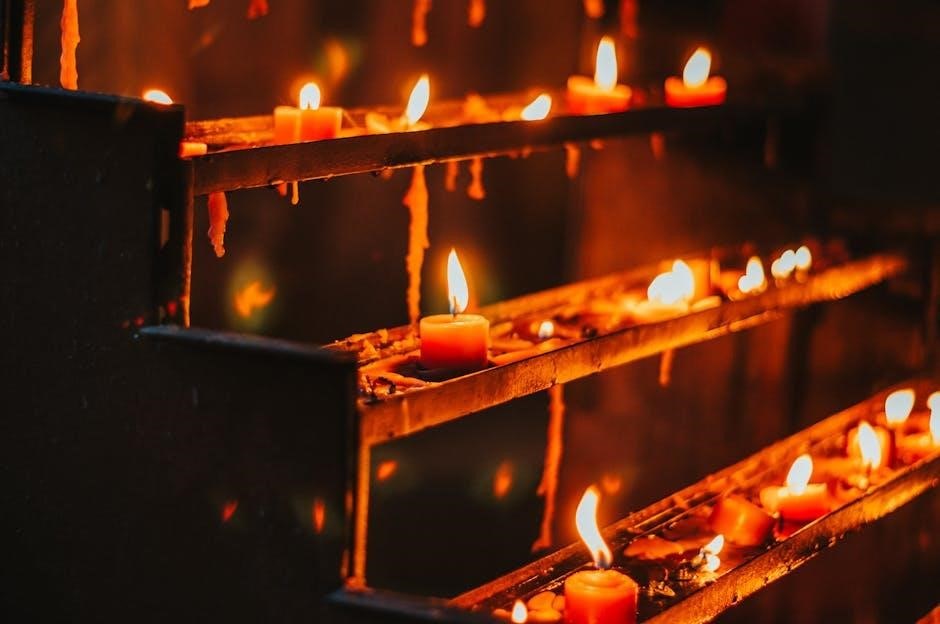
Flat Braided Wicks
Flat braided wicks are the most common type‚ known for their versatility and performance. Made from braided or knitted cotton fibers‚ they are ideal for a wide range of candles‚ including votives‚ pillars‚ and gel candles. These wicks are highly adaptable‚ performing well in various wax types such as soy‚ paraffin‚ and blends. Their flat design promotes consistent capillary action‚ ensuring a steady flame and even burn. Flat braided wicks are a popular choice for both beginners and experienced candle makers due to their reliability and ease of use. They are also less likely to mushroom compared to other types‚ making them a practical option for achieving clean‚ efficient burns.
Square Braided Wicks
Square braided wicks are a specialized type designed for specific candle-making needs. Unlike flat wicks‚ their square shape provides added rigidity‚ making them ideal for container candles with higher fragrance loads or larger diameters. The unique braiding allows for a slightly larger fuel flow‚ which helps maintain a consistent flame height and prevents the wick from becoming too submerged in the wax pool. Square wicks are particularly effective in soy and blended waxes‚ where they enhance burn stability. They are also a good choice for candles with complex fragrances‚ as they help ensure a strong scent throw without compromising burn quality. Their durability makes them a favorite among candle makers seeking reliable performance in challenging formulations.
Cored Wicks and Their Variations
Cored wicks are a versatile option in candle-making‚ featuring a central core made of materials like paper‚ cotton‚ zinc‚ or tin. This core provides structural support‚ keeping the wick upright in molten wax and ensuring a stable flame. Zinc-cored wicks are widely used but may require careful sizing to minimize mushrooming. Paper-cored wicks are eco-friendly and lead-free‚ making them a popular choice for sustainable candle-making. Cored wicks are ideal for container candles‚ votives‚ and gel candles‚ offering consistent burn performance. Their rigidity and durability make them suitable for a variety of wax types‚ though proper sizing is essential for optimal results. With their robust design‚ cored wicks are a reliable choice for both beginners and experienced candle makers.
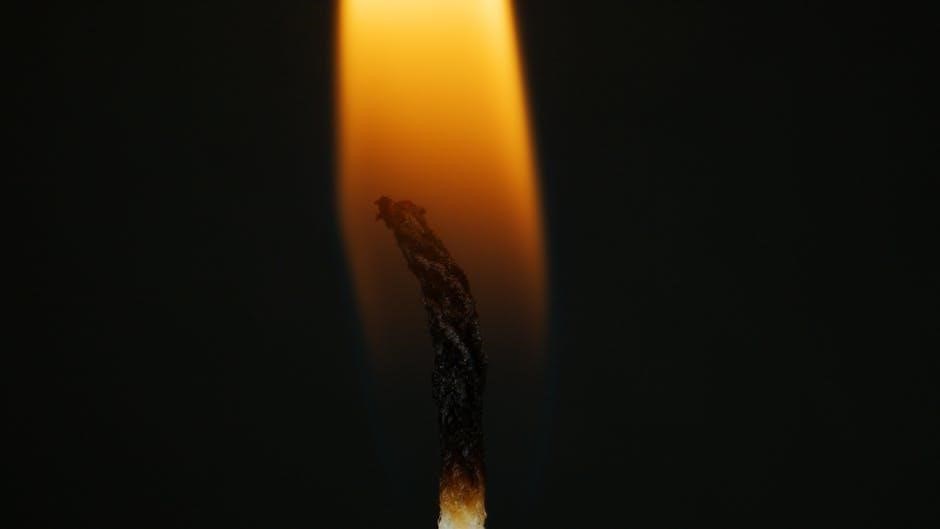
Specialty Wicks for Unique Candle Designs
Specialty wicks offer innovative solutions for unique candle designs‚ adding an extra layer of creativity and functionality. Wooden wicks‚ for instance‚ create a soothing crackling sound when burned‚ enhancing the sensory experience. Scented wicks infuse additional fragrances‚ while multi-wick setups provide even burning and increased fragrance throw. These wicks are ideal for artisanal candles‚ providing distinctive visual and auditory elements. Whether you’re crafting layered‚ textured‚ or multi-wick candles‚ specialty wicks help create standout pieces that elevate your designs beyond the ordinary. Experimenting with these options allows candle makers to push creative boundaries and cater to specific aesthetic or sensory preferences‚ making each candle truly unique.
Wooden Wicks and Their Benefits
Wooden wicks bring a unique charm to candles with their soft crackling sound‚ reminiscent of a fireplace. Unlike traditional cotton or paper wicks‚ wooden wicks provide a multisensory experience‚ combining sight‚ sound‚ and scent. They are eco-friendly‚ often sourced from sustainable materials‚ and produce minimal soot or smoke when properly maintained. Wooden wicks are ideal for those seeking a natural‚ rustic ambiance and are frequently used in luxury or artisanal candles. However‚ they require precise sizing and wick trimming to ensure optimal burn performance. This distinctive feature makes wooden wicks a popular choice for candle makers aiming to create memorable and visually appealing products.

Factors to Consider When Choosing a Candle Wick
Selecting the right wick involves considering wax type‚ candle size‚ fragrance load‚ and desired burn characteristics. These factors ensure optimal performance‚ even burning‚ and a consistent flame height.
Understanding Wax Types and Their Impact on Wick Choice
Wax type plays a critical role in determining the appropriate wick for your candle. Different waxes‚ such as soy‚ beeswax‚ and paraffin‚ have unique properties that influence wick selection. Soy wax‚ for instance‚ is denser and may require a larger wick to ensure proper burning. Beeswax‚ with its natural rigidity‚ often pairs well with flat or square braided wicks. Paraffin wax‚ being softer‚ may need a wick that maintains a consistent flame height without excessive mushrooming. Fragrance load also impacts wick choice‚ as higher concentrations of fragrance oil can clog the wick‚ requiring a larger size to maintain even burning. Understanding the specific characteristics of your wax ensures a balanced and efficient burn‚ enhancing both performance and longevity of your candle.
Candle Size and Diameter Considerations
Candle size and diameter are essential factors in selecting the right wick. Larger candles require thicker wicks to ensure even burning and prevent tunneling or uneven wax consumption. The diameter of the candle directly impacts the wick size‚ as a wider candle needs a wick that can draw wax efficiently across the entire surface. A wick that is too small may result in a weak flame‚ while one that is too large can cause excessive soot or a mushrooming effect. Testing different wick sizes for your specific candle dimensions is crucial to achieve the perfect burn. Always consider the candle’s intended use and desired burn characteristics when matching wick size to diameter for optimal performance.
Fragrance Load and Its Effect on Wick Performance
Fragrance load significantly impacts wick performance‚ as higher concentrations of fragrance oil can affect how the wick burns. A wick must be able to handle the increased fuel load without causing the flame to become too large or unstable. Excessive fragrance can lead to issues such as wick mushrooming‚ soot formation‚ or an inconsistent burn. Choosing the right wick size and type is crucial to ensure it can efficiently draw and burn the wax-fuel mixture. Testing different wick sizes with varying fragrance loads helps determine the optimal balance for clean‚ even burning and consistent fragrance throw. Always consider the maximum recommended fragrance load for your specific wax type to maintain performance and safety.
Burn Characteristics and Desired Flame Height
Burn characteristics‚ such as the size and stability of the flame‚ are directly influenced by the wick’s type‚ size‚ and material. A properly selected wick ensures a consistent and even burn‚ while the wrong choice can lead to an unstable or overly large flame. The desired flame height varies depending on the candle’s purpose and wax type‚ but it should ideally be steady and free from flickering. The wick’s ability to maintain a clean‚ controlled burn is crucial for both performance and safety. Testing different wick sizes helps achieve the perfect balance between flame height and burn quality‚ ensuring a smooth‚ consistent experience. Always prioritize wick compatibility with your wax and fragrance load to optimize burn characteristics and achieve the desired flame height.
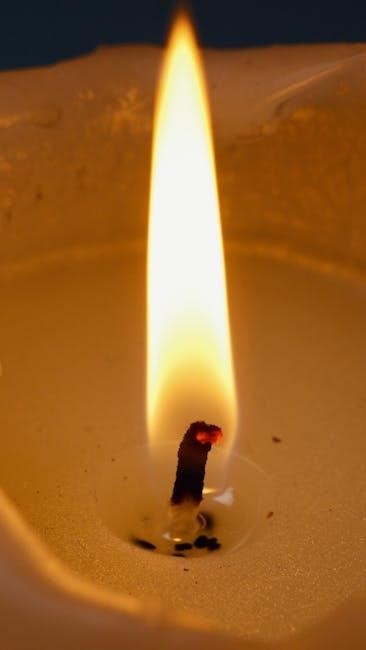
How to Prepare and Treat Candle Wicks
Properly preparing and treating candle wicks ensures optimal performance. Start by cutting the wick to the correct length and cleaning it to remove any residues. Regular maintenance‚ like trimming and testing‚ guarantees a smooth‚ consistent burn experience.
Proper Cutting and Sizing of Wicks
Correctly cutting and sizing wicks is essential for achieving a clean‚ consistent burn. Start by measuring the wick according to your candle size‚ ensuring it fits snugly within the container. Use sharp scissors or a wick trimmer to prevent fraying. For most candles‚ a wick length of 1/4 to 1/2 inch is ideal. Testing different lengths can help determine the best fit for your specific wax type and container diameter. Proper sizing avoids issues like mushrooming or uneven burning‚ ensuring a safe and efficient burn every time. Regular trimming after each use further enhances performance and longevity of your candle.
Cleaning and Maintaining Wicks for Optimal Performance
Regular wick cleaning and maintenance are vital for ensuring a smooth‚ consistent burn. After each use‚ trim the wick to 1/4 inch to prevent excessive flame height and soot formation. Gently remove any debris or residue using a clean‚ dry cloth or paper towel. For stubborn buildup‚ lightly soak the wick in warm water or a small amount of vinegar‚ then rinse thoroughly. Avoid harsh chemicals‚ as they can damage the wick material. Properly dried and trimmed wicks ensure a cleaner burn‚ reduce smoke‚ and extend the life of your candle. Regular maintenance also helps prevent mushrooming and uneven burning patterns‚ keeping your candle performing at its best.
Testing Wicks for Compatibility and Burn Quality
Testing wicks is crucial to ensure they are compatible with your wax and provide a clean‚ even burn. Start by selecting wicks recommended for your wax type. Create small test candles with the same wax and fragrance but different wicks to compare performance. Light the candles in a controlled environment and observe the flame size‚ stability‚ and whether the wax pools evenly. Note any sooting‚ smoke‚ or mushrooming at the wick tip. Measure flame height and track burn time‚ ensuring consistent results across multiple tests. Use tools like a ruler‚ stopwatch‚ and documentation methods to record observations. Conduct multiple burns to account for environmental factors. Always prioritize safety‚ keeping tests away from flammable materials and never leaving burning candles unattended. By systematically evaluating each wick’s performance‚ you can identify the most compatible option for optimal burn quality and safety.

Troubleshooting Common Candle Wick Issues
Address issues like wick mushrooming‚ soot formation‚ and uneven burning by adjusting wick size‚ ensuring proper wax-wick compatibility‚ and maintaining clean‚ consistent burn conditions for optimal performance.
Resolving Wick Mushrooming Problems
Wick mushrooming occurs when the wick forms a bulbous shape during burning‚ often due to improper sizing or material. To resolve this‚ ensure the wick size matches the candle’s diameter and wax type. Choosing a wick with a sturdy core‚ like zinc or paper‚ can help maintain shape. For softer waxes‚ consider using a wick with a stronger core to prevent excessive mushrooming. Additionally‚ trimming the wick to the recommended length before each burn can mitigate this issue. Testing different wick sizes and types is essential to find the best fit for your candle recipe and ensure a clean‚ even burn.
Preventing Soot Formation and Smoke
Soot and smoke can mar the appeal of a burning candle‚ often caused by an improperly sized wick or wick material. To prevent this‚ ensure the wick is trimmed to the recommended length before each use. A wick that’s too long can produce excessive smoke and soot. Additionally‚ using a wick with a sturdy core‚ such as zinc or paper‚ can help maintain a clean burn. Avoid using wicks with lead‚ as they can emit harmful fumes. Regular testing of different wick sizes and types is crucial to find the optimal fit for your candle recipe. Proper wick alignment and ensuring the wax is of high quality also play a role in minimizing soot formation and smoke.
Addressing Uneven Burning Patterns
Uneven burning patterns in candles can be frustrating and affect their aesthetic appeal. This issue often arises from an incorrect wick size or wick placement. A wick that is too small may not melt the wax evenly‚ leading to tunneling or an uneven surface. Conversely‚ a wick that is too large can cause the wax to melt too quickly‚ creating an inconsistent burn. To address this‚ ensure the wick is properly centered and securely anchored. Testing different wick sizes and types‚ such as flat or square braided wicks‚ can help achieve a more uniform burn. Additionally‚ maintaining a consistent wax pour temperature and avoiding excessive fragrance loads can improve burn performance. Regular wick trimming and monitoring are also essential for preventing uneven burning patterns.
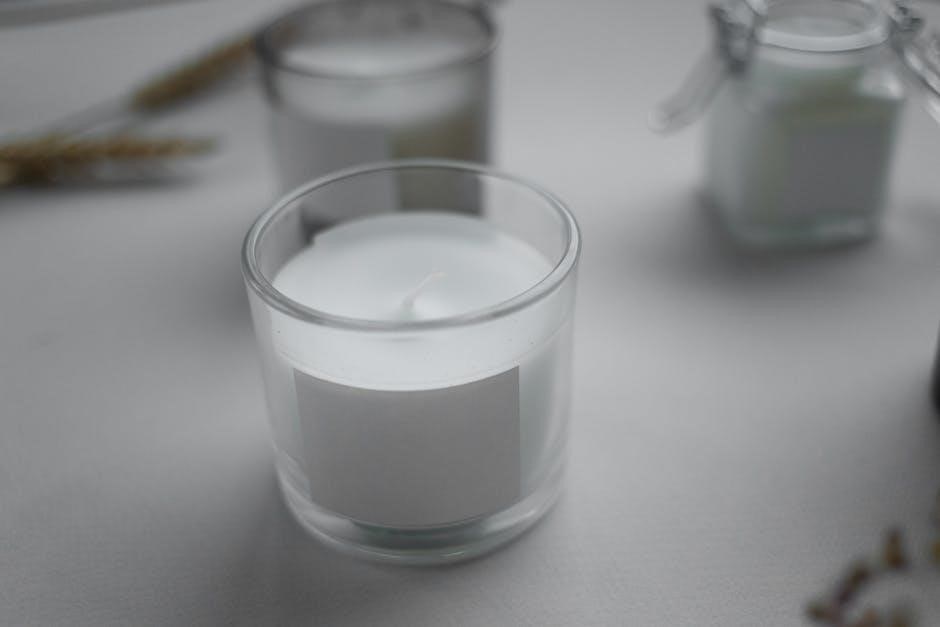
Sustainable and Eco-Friendly Wick Options
Explore sustainable wick options like organic cotton‚ lead-free materials‚ and paper-core wicks. These eco-friendly choices reduce environmental impact and promote cleaner‚ more efficient burns.
Exploring Organic and Lead-Free Wicks
Organic and lead-free wicks are a sustainable choice for eco-conscious candle makers. Made from natural materials like cotton or paper‚ these wicks eliminate harmful toxins during burning‚ promoting cleaner air quality; Lead-free options are particularly popular due to their safer‚ non-toxic properties. Organic wicks are biodegradable and free from synthetic chemicals‚ aligning with environmentally friendly practices. They are ideal for candles made from natural waxes like soy or beeswax. While they may require more precise sizing for optimal burn performance‚ organic and lead-free wicks offer a greener alternative for those prioritizing health and sustainability. This makes them a preferred choice for artisanal and eco-focused candle creations.
Using Paper-Core Wicks for a Greener Choice
Paper-core wicks are an eco-friendly alternative‚ offering a sustainable solution for candle makers. Unlike traditional metal-cored wicks‚ paper-core options are biodegradable and free from harmful materials. They are ideal for container candles‚ votives‚ and tealights‚ providing a stable burn with minimal soot. These wicks are particularly suited for soy and beeswax‚ promoting a cleaner‚ more natural burn. Their environmentally friendly design makes them a popular choice for those prioritizing sustainability. While they may require precise sizing for optimal performance‚ paper-core wicks are a greener option that aligns with eco-conscious practices‚ enhancing the appeal of your candles for environmentally aware consumers.
Advantages of Reusable and Recyclable Wicks
Reusable and recyclable wicks offer a sustainable solution for eco-conscious candle makers. These wicks are designed to be used multiple times or recycled‚ reducing waste and environmental impact. Unlike traditional wicks‚ reusable options can be cleaned and reinserted into new candles‚ extending their lifespan. Recyclable wicks‚ often made from biodegradable materials like paper or wood‚ align with green practices. They minimize the carbon footprint of candle production and appeal to consumers seeking environmentally friendly products. Additionally‚ these wicks maintain consistent burn performance and produce minimal soot‚ ensuring a clean and efficient flame. By embracing reusable and recyclable wicks‚ candle makers can promote sustainability while delivering high-quality‚ eco-friendly candles to their customers.

Candle Safety Tips and Best Practices
Always keep candles away from flammable materials and monitor burn time to prevent overheating. Trim wicks to 1/4 inch for optimal flame height and reduced soot. Use stable holders and ensure proper ventilation for a safe‚ smoke-free burn experience.
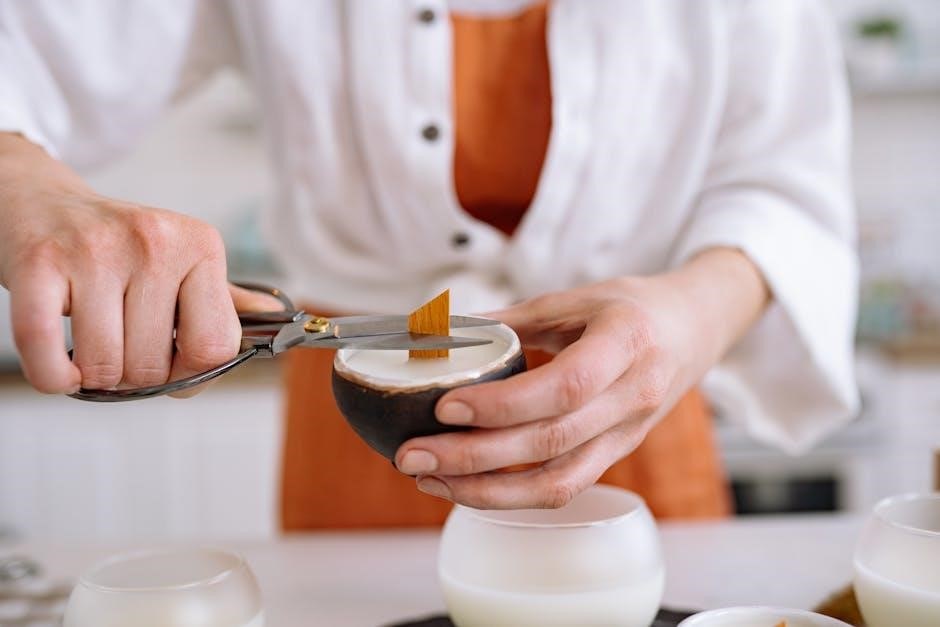
Essential Safety Precautions for Candle Burning
Ensuring safety while burning candles is paramount to prevent accidents. Always place candles on stable‚ heat-resistant surfaces away from flammable materials like curtains or furniture. Never leave a burning candle unattended or near children or pets. Trim the wick to 1/4 inch before lighting to maintain a steady‚ controlled flame. Avoid burning candles for extended periods‚ as this can cause overheating and uneven burning. Keep the burn area well-ventilated to reduce soot and smoke. Never extinguish a candle with water‚ as it can cause hot wax to splatter; instead‚ use a snuffer or gently press the wick into the wax. Store candles in a cool‚ dry place away from direct sunlight to preserve their quality and performance.
Best Practices for Wick Maintenance and Replacement
Proper wick maintenance is crucial for ensuring a clean‚ even burn and extending the life of your candle. Always trim the wick to 1/4 inch before each use to prevent excessive flame height and soot formation. Avoid using water to extinguish a candle‚ as it can cause wax splatters; instead‚ use a snuffer or gently press the wick into the melted wax. Regularly inspect the wick for signs of damage‚ such as fraying or discoloration‚ and replace it if necessary. For candles with removable wicks‚ clean or replace the wick if it becomes discolored or misshapen. Proper maintenance ensures a safer‚ more consistent burn and enhances the overall performance of your candle.